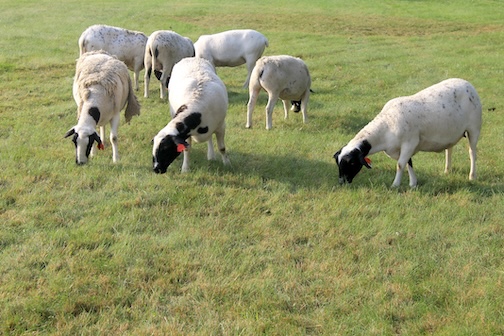By Jacki Martinez Perkins, MOFGA’s Organic Dairy and Livestock Specialist
Parasite monitoring is an important part of raising livestock (and, in case you’re dissuaded from raising livestock due to parasites, I’ve got news for you: everyone has internal parasites). Arguably, healthy bodies can manage a low-grade level of internal parasites in their systems as a natural balance and never notice. It’s when too much stress is placed on the system that disease flourishes and problems arise. When this happens, sometimes a chemical intervention is needed to reset the system. For livestock producers that find routine chemical intervention a necessary part of their management, a restructuring of their overall system is in order. This can mean something as simple as devising a way to keep forages clean as they are fed, or it might require an entirely redesigned grazing plan.

Organic management takes a holistic approach and using chemical intervention is low on the list of preferred practices. Livestock producers transitioning from a conventional approach can find managing internal parasites one of the more challenging aspects of maintaining organic certification. Some species and stages of life are more susceptible to internal parasite overloads than others. For example, sheep and goats are notorious for needing routine deworming, and recently weaned calves are at higher risk of showing symptoms of parasitic infestations of various kinds. As managers, we can quite often trace these issues back to a breakdown of how these creatures evolved. In short, if there’s a problem, it’s generally our fault.
Studying the natural lifecycle of an organism is the best way to learn to manage that organism. The typical lifecycle of internal parasites involves being introduced to the body of a host mammal; completing a life stage inside that mammal; and either making more eggs that are excreted in feces to become the next generation to be ingested, or existing and mating as an adult outside the host, subsequently laying eggs where they can in turn be introduced to a new host.
Well-established, healthy grazing systems are ones that have been designed to mitigate parasitic infestation, and to disrupt their breeding lifecycles. For example, some kinds of bot flies need to lay eggs in mosquitos in order for them to be transferred to a host. Eliminating breeding grounds for mosquitoes reduces the risk of many factors, including issues with these kinds of bot flies. A large library of internal parasites like barber pole worms, hookworms, roundworms, tape worms, and pin worms are found in the soil. Therefore, reducing soil contact is key to avoiding infestations. Overgrazing an area is directly related to higher infestation rates of these internal parasites. Additionally, many larval stages of parasites are able to travel along the wet stems of grasses. The plant crown area can stay moist enough to allow parasitic larva to live, and managers should never allow livestock to graze below this point. Similarly, farms experiencing particularly wet conditions also harbor larva that may potentially travel further up the grass stem than expected. Adjusting grazing times and dates to mitigate these factors leads to a reduction in fecal egg counts. Strategies such as waiting to graze after the morning dew has dried or avoiding grazing wet areas until later in the season can help control infestation events.
Transitioning livestock away from routine chemical intervention (which is not allowed in organic production) usually means replacing treatments with fecal monitoring and recording fecal egg counts for comparison. To do this, one must invest in a microscope capable of 10x magnification and microscope slides, and some training on how to set it up. There are herbal supplements on the market, such as oregano oil, that can reduce fecal egg counts, but they need to be fed constantly and cannot be used on an as-needed basis. Some targeted planting of forages high in tannins, such as vetch, can help to manage fecal egg counts as well. These can be integrated into a grazing system by timed, targeted grazing events. For example, planting a plot of vetch and allowing sheep to graze at the end of the season when fall rains rehydrate dormant populations of larva can reduce the parasite load. Goats can be allowed to forage woody species such as young oaks, chestnuts, or cherry trees at various times of the year to help purge their systems.
There are many internal and external parasites that farm managers need to be aware of, and educated about, but keeping conditions as clean and healthy as possible will help to reduce the impact parasites can have on our livestock.
This article was originally published in the summer 2025 issue of The Maine Organic Farmer & Gardener.